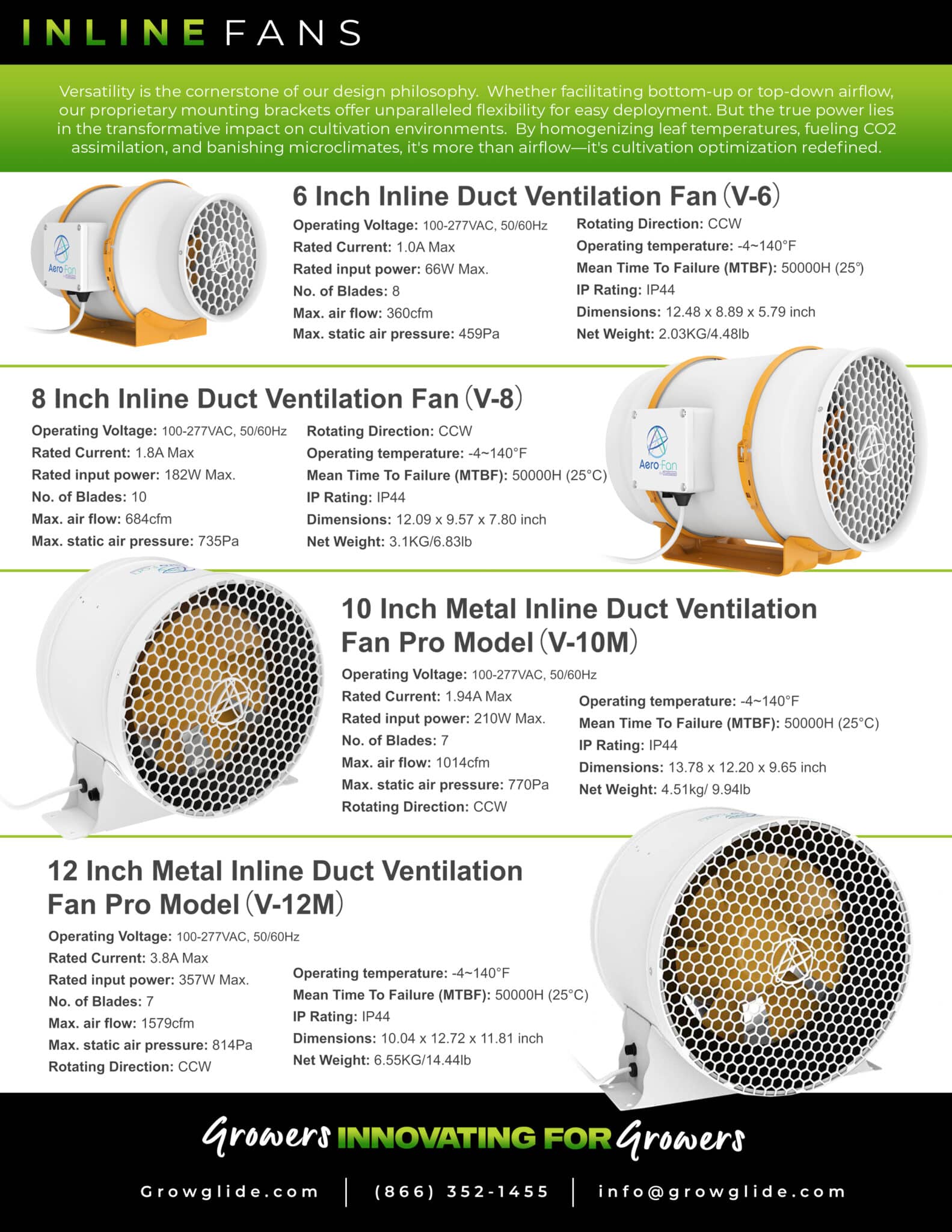In cannabis cultivation, maintaining optimal environmental conditions is crucial for maximizing yield and quality. Fans play a vital role in regulating temperature, humidity, and air circulation. When comparing EC (Electronically Commutated) fans to traditional AC (Alternating Current) fans, EC fans offer several distinct advantages in terms of efficiency, performance, and controllability.
AC fan / EC fan comparison
With an EC fan, less power input is required to achieve the same fan speed as the AC fan, hence the power-saving potential
https://www.airedale.com/energy-upgrades/
Efficiency
- Energy Consumption:
- EC Fans: These fans are highly energy-efficient. They use brushless DC motors controlled by electronic circuits, which allow for precise speed regulation and minimal energy loss. EC fans can operate at lower speeds with high efficiency, leading to significant energy savings.
- AC Fans: AC fans are less efficient because they rely on alternating current and typically run at fixed speeds. Adjusting their speed often involves additional energy loss and inefficiency.
- Heat Production:
- EC Fans: Produce less heat due to their higher efficiency and better motor design. This is crucial in a controlled environment like a grow room, where excess heat can impact plant health.
- AC Fans: Generate more heat, which can contribute to unwanted temperature increases in the grow room.
Image source: https://www.pumpindustry.com.au/fans-in-industrial-applications-big-cooling-tasks-need-efficient-fans/
Performance
- Airflow Control:
- EC Fans: Provide precise control over airflow. The electronic control allows for fine-tuning of fan speed to match the exact requirements of the growing environment, ensuring optimal air circulation and climate control.
- AC Fans: Typically offer less precise control. Speed adjustments are usually limited to a few preset levels, which can lead to less optimal air circulation and environmental control.
- Noise Levels:
- EC Fans: Generally quieter than AC fans because they can operate efficiently at lower speeds and with less mechanical friction. Lower noise levels contribute to a more comfortable working environment and reduce the risk of stress on plants.
- AC Fans: Tend to be noisier, especially at higher speeds, which can be disruptive in a cultivation facility.
EC fan Diagram: https://freefronsm.best/product_details/53089000.html
Controllability
- Speed and Variable Control:
- EC Fans: Feature advanced electronic controls that allow for variable speed settings. This means growers can precisely adjust the airflow to match the specific needs of different stages of plant growth, from seedlings to flowering.
- AC Fans: Limited in controllability, often requiring external devices to adjust speed, which can be less accurate and more cumbersome.
- Integration with Automation Systems:
- EC Fans: Easily integrated with modern climate control and automation systems. This integration allows for dynamic adjustments based on real-time data from sensors monitoring temperature, humidity, CO2 levels, and other environmental factors.
- AC Fans: More challenging to integrate with automation systems, often requiring additional hardware and more complex setups to achieve similar levels of control.
Longevity and Maintenance
- Durability:
- EC Fans: Typically have a longer lifespan due to their efficient design and lower operating temperatures. The brushless motors have fewer moving parts, which reduces wear and tear.
- AC Fans: Generally have a shorter lifespan and may require more frequent maintenance and replacement due to higher operating temperatures and more mechanical components.
- Maintenance:
- EC Fans: Require less maintenance due to the advanced technology and fewer mechanical parts. This can lead to lower long-term costs and less downtime for maintenance activities.
- AC Fans: Often need more frequent maintenance, which can interrupt cultivation processes and increase operational costs.
Environmental Impact
- Energy Efficiency:
- EC Fans: Their high energy efficiency results in lower electricity consumption, reducing the overall carbon footprint of the cultivation facility. This often makes the facility eligible for Utility Rebates.
- AC Fans: Higher energy consumption contributes to a larger carbon footprint.
- Resource Usage:
- EC Fans: Use fewer resources over their lifespan due to their durability and efficiency, leading to less frequent replacement and lower waste.
- AC Fans: More frequent replacements and higher energy usage can result in greater resource consumption and waste.
Top Ten Reasons you should choose EC fans and not AC fans for your cultivation facility.
1. Energy Efficiency and Utility rebates
EC Fans: Use brushless DC motors controlled by electronic circuits, resulting in significantly lower energy consumption. They are highly efficient even at lower speeds.
AC Fans: Generally consume more electricity and are less efficient, especially at varying speeds.
2. Precise Speed Control
EC Fans: Offer precise, variable speed control through electronic modulation, allowing for fine-tuning of airflow to meet specific environmental needs.
AC Fans: Typically have limited speed settings and require external devices for speed adjustment, which can be less accurate.
3. Lower Heat Generation
EC Fans: Generate less heat due to their efficient operation, helping to maintain a stable growing environment and reduce cooling costs.
AC Fans: Produce more heat, which can increase the temperature in the grow room and require additional cooling.
4. Quieter Operation
EC Fans: Operate more quietly, as they can run efficiently at lower speeds and have fewer mechanical parts creating noise.
AC Fans: Tend to be noisier, especially at higher speeds, which can be disruptive in a cultivation facility.
5. Longer Lifespan
EC Fans: Have a longer lifespan due to their advanced technology and fewer moving parts, reducing wear and tear.
AC Fans: Generally have more mechanical components that can wear out faster, leading to a shorter lifespan.
6. Lower Maintenance Requirements
EC Fans: Require less maintenance because of their durable design and efficient operation, leading to lower long-term costs.
AC Fans: Often need more frequent maintenance and repairs, increasing operational interruptions and costs.
7. Better Integration with Automation Systems
EC Fans: Easily integrate with modern climate control and automation systems, allowing for dynamic adjustments based on real-time data from environmental sensors.
AC Fans: More challenging to integrate with automation systems, often requiring additional hardware and complex setups.
8. Improved Airflow and Performance
EC Fans: Provide consistent and optimal airflow tailored to the needs of different stages of plant growth, improving overall plant health and yield.
AC Fans: Less precise control over airflow can lead to less optimal environmental conditions.
9. Reduced Environmental Impact
EC Fans: Their high energy efficiency results in lower electricity consumption, reducing the overall carbon footprint of the cultivation facility.
AC Fans: Higher energy consumption and more frequent replacements contribute to a larger carbon footprint.
10. Flexibility and Adaptability
EC Fans: Offer greater flexibility in installation and usage, as they can be easily adapted to different setups and requirements due to their electronic control systems.
AC Fans: Less adaptable and may require more significant modifications to fit into varying cultivation environments.
This is a fan efficiency model showing that EC fans have less loss and deliver more power/air.
Conclusion
In summary, EC fans offer unparalleled benefits over traditional AC fans, including superior energy efficiency, precise speed control, reduced heat and noise generation, longer lifespan, and easier integration with automation systems. These advantages are critical for maintaining the optimal environmental conditions necessary for maximizing cannabis yield and quality.
At Grow Glide, we are dedicated to leveraging these benefits through our advanced airflow solutions specifically designed for cannabis cultivation. Our flagship products, AirGlide and Updraft, utilize state-of-the-art EC fan technology to provide comprehensive and customizable airflow management.
AirGlide ensures consistent air distribution from above the plants, promoting healthy canopy development and efficient temperature control. Meanwhile, Updraft delivers targeted airflow from below, driving CO2 efficiency, homogenizing root zone temperature and reducing humidity-related issues.
By integrating EC fans into our AirGlide and Updraft systems, Grow Glide not only helps you achieve optimal growing conditions but also contributes to energy savings and sustainability. Trust Grow Glide to deliver the most effective and efficient airflow solutions tailored to the unique demands of cannabis cultivation.
Experience the difference that advanced EC fan technology can make in your grow room with Grow Glide’s innovative airflow systems. Maximize your yields, improve plant health, and ensure a thriving cultivation environment with AirGlide and Updraft.
For more information on how our solutions can benefit your cultivation operations, visit our website or contact our expert team today.
Thank you for choosing Grow Glide, where innovation meets cultivation excellence.


















